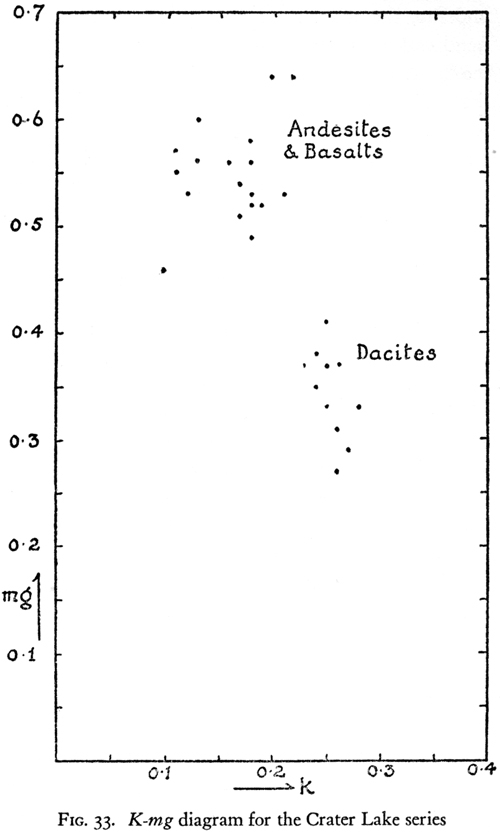The activity of Mount Mazama itself began, as we have seen, with the eruption of hypersthene andesite, and during most of its history the volcano erupted no other type of magma. At the northern end of the Cascade Range, on Mounts Rainier and Baker, this is the only type of magma represented. Southward, however, the variety of magmas erupted by the major cones of the High Cascades shows an almost regular increase. This southward increase in the diversity of the products of the Pleistocene and younger cones of the High Cascades has been emphasized repeatedly since it was first detected by Hague and Iddings. Its cause remains unknown.
The hypersthene andesites of Mount Mazama, like those of the circum-Pacific volcanoes in general, are characterized by an abundance of porphyritic feldspar. In this respect they contrast strongly with most of the pre-Mazama basalts and basaltic andesites. This difference implies more advanced crystallization of the hypersthene andesite magma prior to eruption, and helps to explain why it was more explosive than the earlier, more basic magmas.
Hornblende andesite lavas are rare throughout the High Cascades. In the Crater Lake region, only two examples are known. Between Mount Mazama and Mount Shasta, only one occurrence is known, namely in the dome on the summit of Rustler Peak. On Mount Shasta, hornblende andesite is best developed in the dome of Black Butte. On Mount St. Helens, the plugs (domes) invariably carry hornblende. In brief, hornblende andesite lava is almost confined to quickly chilled viscous domes erupted from parasitic vents.

Fig.33. K-mg diagram for the Crater Lake series |
On the other hand, hornblende is extremely abundant in the basic scoria flows of Mount Mazama. It is also common in the dacite pumice and almost ubiquitous, though in small amount, among the glassy dacite domes and flows erupted from the Northern Arc of Vents. Yet among the holocrystalline, pilotaxitic dacites of Mazama, the mineral is scarcely ever present. Hence, rapid cooling appears to be necessary to prevent complete resorption of the mineral in magmas of shallow origin.

